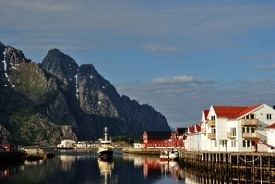Country Norway District Øst-Finnmark Area rank 58 in Norway Area 1,433 km² Administrative center Båtsfjord | County Finnmark Administrative centre Båtsfjord Demonym(s) Båtsfjording Local time Thursday 5:18 PM Official language form Norwegian Language | |
 | ||
Weather -2°C, Wind NW at 11 km/h, 83% Humidity | ||
Båtsfjord (Northern Sami: Báhcavuotna) is a municipality in Finnmark county, Norway. The administrative centre of the municipality is the village of Båtsfjord. It is the only settlement in the municipality. Båtsfjord Airport is a new, modern airport, located just outside Båtsfjord (village). The Hurtigruten coastal express ferry also has regularly-scheduled stops in Båtsfjord village.
Contents
- Map of BC3A5tsfjord Municipality Norway
- General information
- Name
- Coat of arms
- Government
- Municipal council
- Geography
- Birdlife
- Churches
- Mast for broadcasting
- Commerce
- Notable people
- In popular culture
- References
Map of B%C3%A5tsfjord Municipality, Norway
Historically, there were many other villages in the municipality, but they have been abandoned over the years. Some of these villages include Hamningberg (abandoned in 1964), Makkaur (abandoned in the 1950s), Sandfjord/Ytre Syltefjord (abandoned in 1946), Hamna (abandoned around 1950), and Nordfjord (abandoned in 1989).
General information
Vardø Municipality was established on 1 January 1838 (see formannskapsdistrikt), encompassing the northeastern part of the Varanger Peninsula. In 1839, to comply with the formannskapsdistrikt law, the rural parts of the municipality, outside of the island/town of Vardø, were separated to form the new municipality of Vardø landdistrikt. Initially, Vardø landdistrikt had a population of 245. The new municipality was too small to be an official self-governing municipality, and it was not until 22 May 1868 when a royal resolution was passed that officially declared it a self-governing municipality. On 1 January 1874, a small part of Vardø landdistrikt (population: 48) was transferred to the town of Vardø. On 1 January 1955, the name was changed to Båtsfjord. On 1 January 1964, the eastern fourth of Båtsfjord (population: 621) was transferred to the neighboring Vardø Municipality.
Name
The name was originally Vardø landdistrikt (or Vardø landsogn) which both mean "the rural district of Vardø", since it surrounded the town of Vardø. On 1 January 1955, the name was changed to Båtsfjord since the village of Båtsfjord is the main population centre of the municipality. The Old Norse form of the name is Botnsfjǫrðr. The first element is the genitive case of botn which means "the innermost part of a fjord" and the second part is the Old Norse spelling for "fjord". The village is located at the innermost part of a fjord, so the name has a very straightforward meaning.
Coat-of-arms
The coat-of-arms is from modern times. They were granted on 19 April 1985. The arms show a silver fish hook on a blue background. It was chosen as a symbol for the great economic importance of fishing and fish processing in the municipality. The shape of the hook was derived from ancient Stone Age hooks found in the municipality.
Government
All municipalities in Norway, including Båtsfjord, are responsible for primary education (through 10th grade), outpatient health services, senior citizen services, unemployment and other social services, zoning, economic development, and municipal roads. The municipality is governed by a municipal council of elected representatives, which in turn elect a mayor.
Municipal council
The municipal council (Kommunestyre) of Båtsfjord is made up of 15 representatives that are elected to every four years. Currently, the party breakdown is as follows:
Geography
The municipality is situated on the northeastern coast of the Varanger Peninsula. The rocky, barren landscape has no native trees due to the climate. The Varangerhalvøya National Park lies in the southern part of the municipality. Makkaur Lighthouse lies along the shoreline, near the mouth of the Båtsfjorden, northeast of the village of Båtsfjord.
Previously, there were several villages along this barren coast, but today everyone lives in the village of Båtsfjord, with a sheltered harbor at the end of the Båtsfjorden inlet. The most interesting of the now-abandoned fishing villages is Hamningberg on the outer coast. It has many well-preserved 19th century wooden houses, a unique example of old architecture in a county so devastated by World War II. Now, it is only used for summer vacation stays.
Birdlife
The municipality covers an area of 1,433 square kilometres (553 sq mi) including Finnmark's highest mountain pass over Ordofjell at 400 metres (1,300 ft) above sea level. With the Barents Sea pounding the rocky coastline, Båtsfjord is at the mercy of the elements, but it is a great place to visit with the worlds northernmost gannet colony to be found on the stack at Syltefjordstauran, along the Syltefjorden, north of the now-abandoned village of Nordfjord. The two pairs that were discovered in 1961 have now grown to well over 300 pairs. The northern gannet is just one of many species that can be seen.
Churches
The Church of Norway has one parish (sokn) within the municipality of Båtsfjord. It is part of the Varanger deanery in the Diocese of Nord-Hålogaland. The main church is Båtsfjord Church. There are two other small chapels, but they are only used for special occasions since they are located in uninhabited areas that are only used for summer cottages.
Mast for broadcasting
Commerce
Fishing permits (for salmon fishing) are sold for use on specific rivers, including Sandfjord-elva, Syltefjord-elva and Komag-elva. A crab factory was started in 2015; 20 - 30 million Norwegian kroner was the cost of investment—then employing 28.
Notable people
In popular culture
Båtsfjord was used in the cartoon Metalocalypse's first episode, "The Curse of DethKlok." In the episode, 300,000 people from around the world travel to Båtsfjord to hear the main characters, a death metal band named DethKlok play a little-over-one-minute jingle promoting a fictional coffee company. The episode features a large amount of death by various means, mainly the parachuted stage missing its landing spot. The episode also features James Hetfield and Kirk Hammett of Metallica fame.
